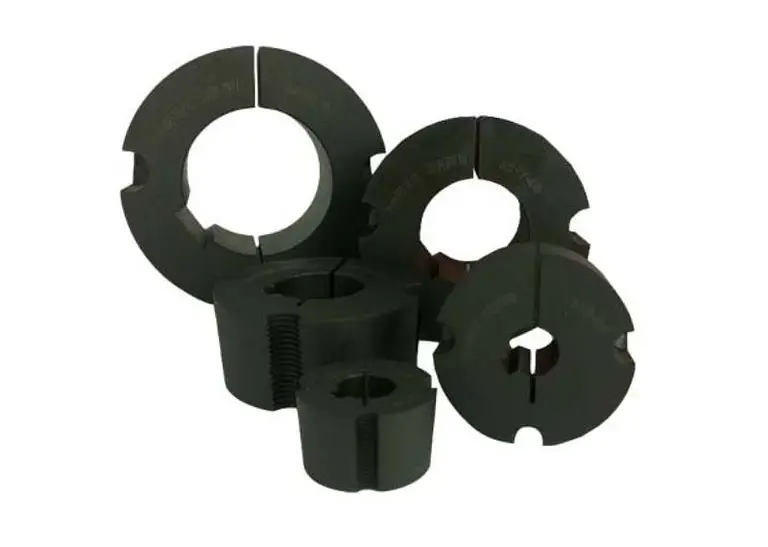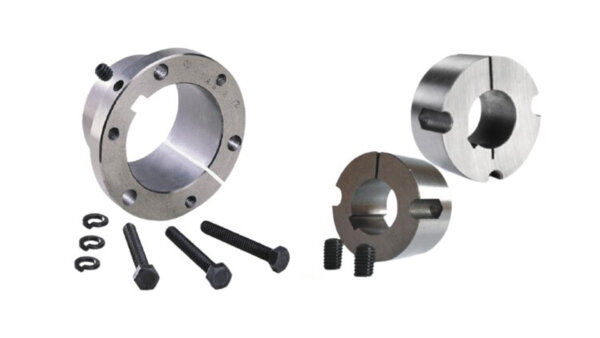Product Description
Product Description
1) Feature of Taper Bushing:
*Easy on-easy off;
*Machined to high precise tolerance;
*A full range of both metric and inch sizes taper bushes are available;
2) Taper Bushings Specification:
| Bushing No. | Bore |
| 1008 | 10.11.12.14.15.16.18.19.20.22.24.25 |
| 1108 | 10.11.12.14.15.16.18.19.20.22.24.25.28 |
| 1210 1215 | 11.12.14.15.16.18.19.20.22.24.25.28.30.32 |
| 1310 | 14.15.16.18.19.20.22.24.25.28.30.32.35 |
| 1610 1615 | 14.15.16.18.19.20.22.24.25.28.30.32.35.38.40.42 |
| 2012 2017 | 18.19.20.22.24.25.28.30.32.35.38.40.42.45.48.50 |
| 2517 2525 | 20.22.24.25.28.30.32.35.38.40.42.45.48.50.55.60 |
| 3571 3030 | 25.28.30.32.35.38.40.42.45.48.50.55.60.65.70.75 |
| 3525 3535 | 35.38.40.42.45.48.50.55.60.65.70.75.80.85.90 |
| 4030 4040 | 40.42.45.50.60.65.70.75.80.85.90.95.100 |
| 4535 4545 | 55.60.65.70.75.80.85.90.95.100.105.110 |
| 5040 5050 | 60.65.70.75.80.85.90.95.100.105.110.115.120.125 |
Detailed Photos
Cast iron taper bushing, phosphated
Carbon steel taper bushing
Each set individually packed
Large stock in warehouse
Catalogue
Packaging & Shipping
Export wooden box
FAQ
Q1: Are you trading company or manufacturer ?
A: We are factory.
Q2: How long is your delivery time and shipment?
1.Sample Lead-times: 10-20 days
2.Production Lead-times: 30-45 days after order confirmed.
Q3: What is your advantages?
1. The most competitive price and good quality.
2. Perfect technical engineers give you the best support.
3. OEM is available.
| Standard Or Nonstandard: | Standard |
|---|---|
| Shaft Hole: | 19-32 |
| Bore Diameter: | 19mm |
| Structure: | Phosphated |
| Material: | Cast Iron |
| Type: | Bushing |
| Customization: |
Available
| Customized Request |
|---|

Can I find information on the compatibility of pulley bushings with various belt types?
Yes, you can find information on the compatibility of pulley bushings with various belt types. It is important to ensure that the pulley bushing and belt type are compatible to ensure proper functioning and longevity of the power transmission system. Here are some sources where you can find information on the compatibility of pulley bushings with different belt types:
- Belt Manufacturer’s Documentation: Belt manufacturers often provide documentation, catalogs, or technical guides that detail the recommended pulley bushing types and specifications for their specific belt products. These resources may outline factors such as belt width, tooth profile, tooth pitch, and recommended pulley bushing materials. Visiting the manufacturer’s website or contacting their customer support can provide valuable information on pulley bushing compatibility.
- Pulley Manufacturer’s Documentation: Pulley manufacturers or suppliers often provide information on the recommended belt types and corresponding pulley bushings for their pulley products. Documentation such as product catalogs, technical specifications, or installation guides may include details on compatible belt types and the required bushing specifications. Checking the manufacturer’s website or contacting their customer support can help you find information on pulley bushing compatibility.
- Engineering Handbooks and Manuals: Engineering handbooks and manuals related to power transmission systems may include information on the compatibility of pulley bushings with different belt types. These resources often cover topics such as belt drives, pulley systems, and bushing selection. Examples of engineering handbooks include the Mechanical Engineer’s Data Handbook and the Mechanical Engineer’s Reference Book. These resources can be found in libraries or as digital publications.
- Industry Associations and Organizations: Industry associations and organizations related to power transmission systems or specific industries may provide guidelines or recommendations on pulley bushing and belt compatibility. Examples include the Power Transmission Distributors Association (PTDA) or the Conveyor Equipment Manufacturers Association (CEMA). Visiting their websites or reaching out to these organizations can provide access to technical resources and industry standards.
- Online Forums and Communities: Online forums and communities dedicated to mechanical engineering, industrial applications, or power transmission systems can be valuable sources of information. Engaging with professionals and enthusiasts in these communities can allow you to seek advice and knowledge-sharing regarding pulley bushing and belt compatibility. Members with experience in similar applications may share their insights and recommendations.
When seeking information on the compatibility of pulley bushings with various belt types, it is important to consider the specific requirements of your application, such as belt width, tooth profile, speed, and load capacity. Consulting reliable sources such as belt and pulley manufacturers, engineering handbooks, industry associations, and online communities will help you find the necessary information to ensure compatibility and optimal performance of the pulley bushings with the chosen belt type.

What are the temperature limits of pulley bushings, and how does it affect their performance?
The temperature limits of pulley bushings depend on various factors, including the materials used in their construction and the specific application requirements. Pulley bushings are typically designed to operate within certain temperature ranges to ensure their performance, durability, and longevity. Here’s an overview of the temperature limits and how they can affect the performance of pulley bushings:
- Material Compatibility: Different materials used in pulley bushings have varying temperature limits. Common bushing materials include metal alloys, plastics, and composite materials. Each material has its own thermal properties and can withstand different temperature ranges. It is important to consult the manufacturer’s documentation or specifications to determine the temperature limits of specific bushing materials.
- High-Temperature Performance: When pulley bushings are exposed to high temperatures beyond their recommended limits, it can lead to various performance issues. For instance, excessive heat can cause the bushing material to soften, deform, or lose its structural integrity. This can result in increased friction, accelerated wear, and reduced load-carrying capacity. Additionally, high temperatures can affect the lubrication properties of the bushing, causing lubricants to break down or evaporate more quickly, leading to inadequate lubrication and increased friction.
- Low-Temperature Performance: Similarly, extremely low temperatures can also impact the performance of pulley bushings. Some materials used in bushings may become brittle or less flexible in cold environments, which can increase the risk of cracking or failure under load. Cold temperatures can also affect the lubricant properties, causing it to thicken or become less effective in reducing friction. It is important to consider the minimum temperature limits of bushing materials to ensure their suitability for specific cold-temperature applications.
- Thermal Expansion: Temperature changes can cause materials to expand or contract. This phenomenon, known as thermal expansion, can affect the dimensional stability of pulley bushings. If the bushing material and the mating components have different coefficients of thermal expansion, significant temperature variations can lead to misalignment or interference between the bushing and the shaft. This can result in increased friction, wear, and potential damage to the bushing or the pulley system.
- Application Considerations: The temperature limits of pulley bushings should be considered in the context of the specific application requirements. Factors such as the operating environment, the presence of heat sources or cooling mechanisms, and the duration of exposure to extreme temperatures should be taken into account. In some cases, additional cooling measures or insulation may be necessary to protect the bushings and ensure optimal performance.
It is important to note that the temperature limits provided by bushing manufacturers are general guidelines, and the actual performance may vary depending on the specific conditions and application parameters. Consulting the manufacturer’s documentation, technical specifications, or contacting their customer support can provide more accurate information on the temperature limits and their impact on the performance of pulley bushings.

Are there video tutorials on installing and removing pulley bushings?
Yes, there are video tutorials available that provide step-by-step instructions on installing and removing pulley bushings. These tutorials can be helpful resources for understanding the process and ensuring proper installation and removal. Here are some ways to access these video tutorials:
1. Online Video Sharing Platforms:
– Visit popular online video sharing platforms such as YouTube or Vimeo. These platforms have a vast collection of instructional videos, including tutorials on various mechanical tasks, including installing and removing pulley bushings.
– Use the search function on these platforms and enter keywords such as “pulley bushing installation” or “pulley bushing removal” to find relevant video tutorials. You can further refine your search by specifying the type of bushing or the specific equipment you are working with.
2. Manufacturer or Supplier Websites:
– Check the websites of pulley manufacturers or power transmission suppliers. Many of them provide resources such as video tutorials or guides on the installation and removal of their products.
– Navigate to the support or resources section of their websites and look for videos specifically related to pulley bushings. These videos are often created by experts who are familiar with the product and can provide valuable insights.
3. Online Mechanical Forums and Communities:
– Join online forums or communities that focus on mechanical topics, such as DIY or engineering forums. These platforms often have members who are willing to share their knowledge and experiences.
– Post a question or search within the forum for discussions or threads related to pulley bushing installation and removal. Members may provide links to helpful video tutorials or share their own experiences and tips.
4. Manufacturer or Supplier Support:
– Reach out to the manufacturer or supplier of the pulley bushings you are working with. They may have dedicated technical support or customer service teams that can provide guidance and direct you to relevant video tutorials.
– Contact them through their website, email, or phone and explain your specific needs. They can assist you in finding the appropriate resources to guide you through the installation and removal process.
Video tutorials can be valuable visual aids when it comes to understanding the intricacies of installing and removing pulley bushings. They often provide practical demonstrations, tips, and troubleshooting advice. By following these tutorials, you can ensure that the installation and removal procedures are carried out correctly, minimizing the risk of damage and ensuring optimal performance of your pulley system.


editor by CX 2023-10-31
